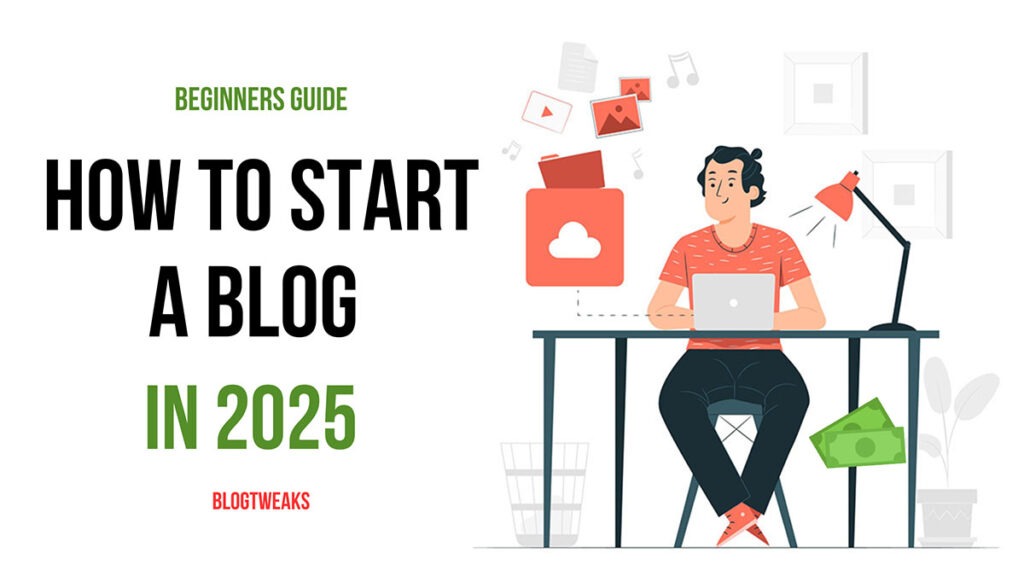Want to start a blog in 2025?
You’re not the only one.
Blogging’s still awesome for sharing what you love, building your name, or making some cash on the side. Folks are all over blogs—to learn stuff, vibe with others, or shop. But here’s the thing. Most newbies? They freeze before they even kick things off.
Too many choices. Tech words that sound like gibberish. Advice yelling “do this, skip that.”
Ugh, no thanks.
I’m going to keep it super easy. This guide walks you from picking what to write about to posting your first thing. No fancy talk. No confusing stuff. Just simple steps you can totally handle—even if websites scare you.
Step 1: Pick a Killer Niche for Your Blog
Before you stress about blog names, fancy designs, or plugins, this comes first.
Your niche? It’s like your blog’s vibe. It tells readers—and Google—what you’re all about.
In 2025, picking a niche isn’t just about what you love. It’s about focus. And cash flow.
A blog that talks about everything? It reaches nobody.
What is a profitable niche?
Easy. It’s where what you love, what you know, and what people search for all click.
Here’s how to nail it:
Real talk: Passion doesn’t always mean profit.
Love collecting old stamps? Cool. But if nobody’s Googling it or buying stamp stuff, you’ll struggle to make money.
Flip that around. Blog about “fitness for busy moms” or “budget travel in India”? Way more people care. Way easier to cash in.
Some Hot Niches Examples for 2025:
See the vibe? These fix real problems people have.
Pick your niche? Boom. You’re already ahead of most new bloggers.
Step 2: Choose a Blog Name and Domain
Alright, you’ve got your niche locked in. Sweet. Now it’s time to name your blog.
This part is fun. But it can trip you up a bit.
Your blog name? It’s like your online handshake.
Here’s what it should be:
How to Pick a Killer Blog Name
Here’s an easy way to brainstorm:
What’s Up with Domain Names?
Your domain? That’s your blog’s address. Like yourblog.com.
Some quick rules:
Try saying it. Type it. Feels awkward? Pick something else.
Don’t stress too hard. Pick something solid. Keep moving.
Where to Snag a Domain
Buy your domain from:
More on hosting in a sec.
Once your name and domain are set, you’re ready to build your blog’s home.
Let’s get your hosting sorted and WordPress fired up.
Step 3: Get Hosting and Set Up WordPress
So, you’ve nailed your niche and blog name. Awesome. Now it’s time to set up your blog’s home on the web.
To do that, you need two things:
-
Web hosting. Where your blog’s files live.
-
WordPress. The platform that makes your blog run.
Why Choose WordPress?
In 2025, WordPress is still top dog.
It powers over 40% of websites. And it’s:
Find a Hosting Provider
Your host stores your blog’s files and keeps it online 24/7 for visitors.
Here are some great picks for new bloggers:
Bonus: Most include a free SSL certificate. That’s key for security and Google rankings.
How to Set Up WordPress (Step-by-Step)
Good news? Most hosts make this crazy easy with a one-click install. Here’s how:
Done. Your blog is officially live.
Pro tip: Save your WordPress dashboard link. You’ll visit it a lot.
Step 4: Design Your Blog
So, your blog’s live. Sweet! Now it’s time to make it look sharp.
No stress—you don’t need to be a pro designer.
With WordPress, it’s all about click, tweak, done.
Pick a WordPress Theme
Your theme? It’s the look of your blog. Think fonts, colors, layout—the whole vibe.
There are tons of themes out there. Don’t get lost scrolling. Just grab a solid one that’s:
Some Great Picks for Newbies:
Quick tip: Skip themes with too many extras. They slow your site down.
Tweak the Basics
Installed your theme? Cool. Head to:
Appearance > Customize in your WordPress dashboard.
Start with these:
Don’t chase perfect. Just make it clean and functional.
Key Design Tips
Want your blog to pop? Try these:
Here’s the thing:
Good design isn’t about flashy. It’s about function.
Step 5: Install Essential Plugins
Alright, your blog’s live and looking sharp. Now it’s time to give it some superpowers.
That’s where plugins come in.
Plugins are like apps for your WordPress blog. They add cool features without you touching any code.
Want better SEO? There’s a plugin for that.
Need a faster site? Plugin.
Contact forms? Yup, plugin.
But here’s the deal:
Too many plugins? Your site crawls.
So, stick to the essentials.
Must-Have Plugins for 2025
Here’s what every new blogger needs:
Rank Math – For SEO– Helps your posts rank on Google.
– Adds meta titles, descriptions, sitemaps.
– Super easy with built-in tips.
Why it rocks: It’s like an SEO checklist you just follow.
WP Rocket (or FlyingPress) – For Speed– Caches your site to load fast.
– Shrinks files, lazy loads images.
– Works right away—no fuss.
– Bonus: Google loves speedy blogs.
UpdraftPlus – For Backups– Saves your blog automatically.
– One-click restore if things go wrong.
– Stores backups on Google Drive or Dropbox.
Site Kit by Google – For Analytics– Shows traffic stats in your dashboard.
– Links to Google Analytics, Search Console, AdSense.
– Tells you what’s working and what’s not.
Optional (But Handy) Plugins
- Akismet. Stops spam comments.
- Pretty Links. Makes affiliate links look clean.
- WPForms. Easy drag-and-drop contact forms.
- WPSmush. Shrinks images without losing quality.
How to Install a Plugin
It’s simple:
- Go to Plugins > Add New in WordPress.
- Search for the plugin name.
- Click Install Now. Then Activate.
Done. You’re good to go.
Step 6: Write and Publish Your First Posts
Your blog’s up and looking great. Now it’s time to make it a real blog.
How? Start writing.
This is where newbies get stuck.
What do I write about?
Is it good enough?
What if nobody reads it?
Chill. Every blogger starts here.
Your first posts won’t be perfect. And that’s fine.
The goal? Progress, not perfection.
Kick Off with 3–5 Big Posts
These are your pillar posts. Stuff that teaches, helps, or solves a problem.
Think:
Pick topics your readers are already searching for.
A Simple Blog Post Structure
Don’t make it complicated. Use this flow:
Quick Writing Tips
How to Publish in WordPress
It’s super easy:
Boom. You’re live.
Your first post? That’s a big deal. Most folks never make it this far.
Step 7: Set Up Pages You Need
Your blog posts are where the magic happens. But pages? They’re your blog’s backbone.
They tell folks:
Let’s set up the must-have pages every blog needs from day one.
1. About Page
Why it’s key: People vibe with people. Your About page is where readers check out your story—and decide if they’re sticking around.
What to include:
2. Contact Page
Why it’s key: Brands want to collab. Readers have questions. You need a simple way for them to get in touch.
What to include:
3. Privacy Policy & Disclaimer Page
Why it’s key: Collecting emails? Using analytics? Planning to make cash with affiliate links or ads? This page is a legal must.
What to include:
4. Start Here Page (Optional but Awesome)
Why it’s key: If your blog helps with something specific—like fitness or budgeting—this page is like a guided tour.
What to include:
How to Add a Page in WordPress
It’s super easy:
Done. Your blog feels solid now—not just a bunch of posts floating out there.
Step 8: Promote Your Blog
Your blog’s looking awesome. But here’s the thing: even the best content won’t shine if nobody sees it.
Time to get some eyes on your blog. Even if you’re starting from zero.
Here’s how to drive traffic like a pro.
1. Share on Social Media
Pick 1–2 platforms where your readers hang out. Don’t try to do all the platforms.
Top spots for bloggers:
2. Join Online Communities
Get active in Facebook groups, Reddit threads, or Discord servers tied to your niche.
How to do it right:
3. Start an Email List Now
Yup, even if you’ve got just one post.
Your email list? It’s your most loyal crowd over time. Start with free tools like MailerLite or Kit (formerly ConvertKit).
What to send:
4. Get Friendly with SEO
SEO helps your posts pop up on Google.
Start simple:
6. Team Up with Other Bloggers
You don’t need a big audience to make blogging buddies.
Ways to connect:
Keep Going, Stay Steady
Blogging’s a long game. Most big blogs took months—sometimes years—to grow traffic.
Stay consistent. Keep helping your readers. The traffic will come.
You’re not just a newbie anymore. You’re building momentum.
Step 9: Monetize Your Blog
Now that your blog’s live and picking up steam, let’s turn that hard work into cash.
Good news? You don’t need a zillion views to start.
What you do need? A smart plan and a little patience.
Here’s how to make money with your blog in 2025.
1. Affiliate Marketing
Share products or services tied to your niche. When someone buys through your unique links, you earn a cut.
Don’t stuff links everywhere. Focus on honest recommendations that help.
2. Display Ads
Use platforms like Google AdSense or Ezoic to put ads on your blog. Get paid for views or clicks.
3. Sponsored Posts & Brand Deals
Got some blog cred? Brands might pay you to write about their stuff.
4. Sell Your Own Stuff
This is where the big money often starts.
Ideas:
5. Cash In on Your Email List
Got an email list? Use it to pitch your products, affiliate offers, or special content.
Mistakes to Dodge
Making money is a long game. Stay steady, try different streams, and always keep your readers’ trust first.
Step 10: Keep Learning and Improving
So, you launched your blog. Huge win! But that’s just the start. The best bloggers? They’re always learning, tweaking, and getting better at their game.
Here’s how to keep leveling up as a blogger.
1. Check What’s Working (and What’s Not)
Use tools like Google Analytics, Search Console, or your email platform to track how things are going.
Action step: Peek at your data every month. Spot patterns. Use them to shape your next posts.
2. Learn from Other Bloggers
Follow top blogs, listen to podcasts, and hang out in online groups tied to your niche or blogging.
3. Keep Sharpening Your Skills
Blogging means wearing lots of hats—writing, SEO, design, marketing, maybe even a bit of coding.
4. Ask Your Readers
Chat with your audience. Ask for comments, run quick surveys, or toss a question at the end of posts.
Feedback helps you improve. Plus, it shows readers you care.
5. Grow with Your Blog
As your blog gets bigger, your style, goals, or audience might shift. That’s not failing—it’s growing.
Be ready to:
Blogging’s a journey. Keep learning, testing, and evolving. Soon, you’ll be a trusted voice in your niche.
Common Blogging Mistakes to Avoid
And, you’re off to a great start with your blog. Nice work! But heads up—new bloggers often hit some tricky traps that can slow you down or burn you out. Dodge these common mistakes to save time and keep your vibe strong.
Here’s what to avoid:
Wrapping up
Launching a blog might feel like a big deal at first. But guess what? You’ve seen it’s totally doable when you break it down into simple steps.
From picking your niche to setting up your site, writing those first posts, and even making some cash—each step stacks up. You’re building a blog that pulls in readers, pays off, and makes a real difference.
Here’s the thing: Success takes time. The best bloggers? They keep showing up. They keep learning. They tweak things even when it feels like a slog.
So start small. Stay steady. Focus on helping your readers. Bit by bit, your blog can grow into a killer platform that shares your passion, hits your goals, and maybe even changes your life.
You’ve got what it takes. Ready? Jump in and start your blog today.


